Orchids are a large plant family, containing over 28,000 species, and can be found on every continent except Antarctica. It is no surprise that they are popular houseplants, known for their unique and stunning blooms that often have a fragrant aroma. While they may seem intimidating to care for, they are actually not as difficult as you might think.
To care for indoor orchids, plant them in coarse bark or sphagnum moss and provide them with bright, indirect light. Allow the soil to dry completely between waterings.
Orchids generally thrive in temperatures between 70°F and 80°F and a relative humidity range of 40% to 70%. Use a specially formulated orchid fertilizer once a week to promote new growth.
This article covers all the information you need to know about orchid care, including the best orchids to grow indoors, how to propagate and prune them, and other interesting facts. Continue reading for more information.
What Are Orchids?
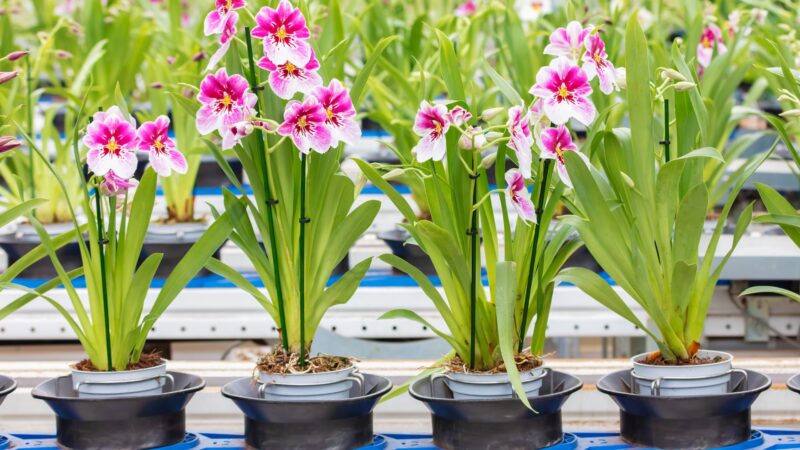
With about 28,000 known species and over 300,000 varieties, orchids are one of the most diverse plants in the world. As such, orchids can be found on every continent except Antarctica. They are popular flowering houseplants grown for their uniquely shaped, attractive, and fragrant flowers.
Are Orchids Hard to Take Care Of?
Orchids are not hard to take care of. When they were first cultivated during the mid-18th century, they acquired a reputation for being challenging plants to grow. However, they are low-maintenance houseplants as long as they are grown under the right conditions.
How Do Orchids Grow?
Monopodial
Monopodial orchids exhibit upright growth and produce shoots on their sides. They do not have pseudobulbs or thickened stems, and their leaves grow opposite one another, perpendicular to the stem. Some examples of orchid genera with monopodial growth habits include Vanda and Phalaenopsis.
Sympodial
Sympodial orchids are characterized by having pseudobulbs attached to a common rhizome and horizontal growth. New shoots grow out from old basal rhizomes.
Their pseudobulbs can store water and nutrients, allowing the plant to survive droughts. Examples of the orchid genus with sympodial growth habits are Dendrobium, Cattleya, Oncidium, and Cymbidium.
What Are the Best Orchids to Keep Indoors?
1. Moth Orchids (Phalaenopsis)
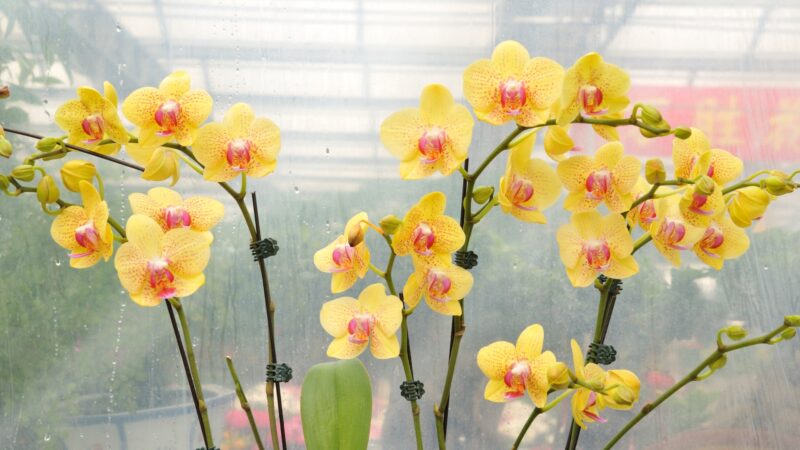
One of the easiest orchids to grow and maintain, the Moth Orchid is characterized by its leathery, strap-shaped leaves and flowers that come in shades of white, pink, and purple, blooming up to thrice a year. If given the proper care, it’s possible to get these orchids to rebloom again.
- Phalaenopsis aphrodite: White flowers with a delicate flush and emerald green leaves
- Phalaenopsis bellina: Flowers have yellow outer edges, turning purple towards the center, and light green leaves
- Phalaenopsis equestris: Light purple or rose-pink flowers streaked with dark red
- Phalaenopsis sanderiana: Fairly pink flowers
- Phalaenopsis schilleriana: Lilac flowers and barred leaves
2. Corsage Orchids (Cattleya)
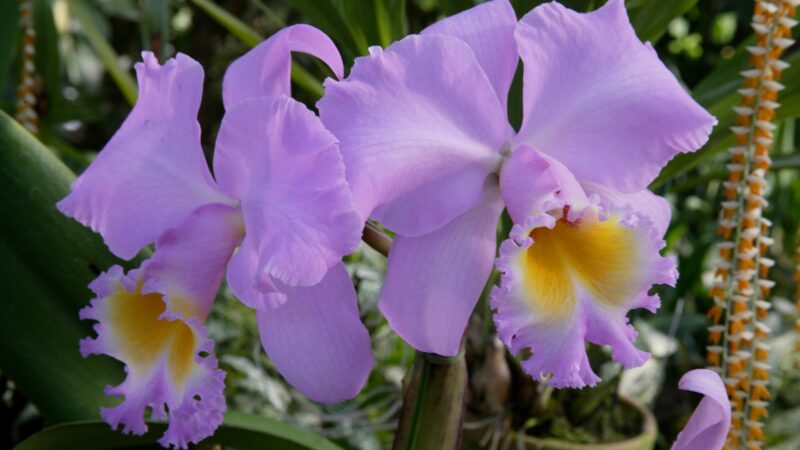
Known for their large, stunning flowers, Cattleya Orchids contain 42 species and a wide variety of hybrids that are available in virtually all colors except true black and blue. They are popular choices for flower arrangements but are largely grown indoors. Under the right conditions, they can bloom up to twice a year.
- Cattleya amethystoglossa: Light lavender to pale rose flowers with magenta or mauve spots
- Cattleya cernua: Reddish-orange flowers and apple-green leaves
- Cattleya intermedia: Lavender-pink flowers with magenta in the center
- Cattleya labiata: Lilac flowers and light green leaves
- Cattleya mossiae: Pale lavender flowers
3. Slipper Orchids (Paphiopedilum)
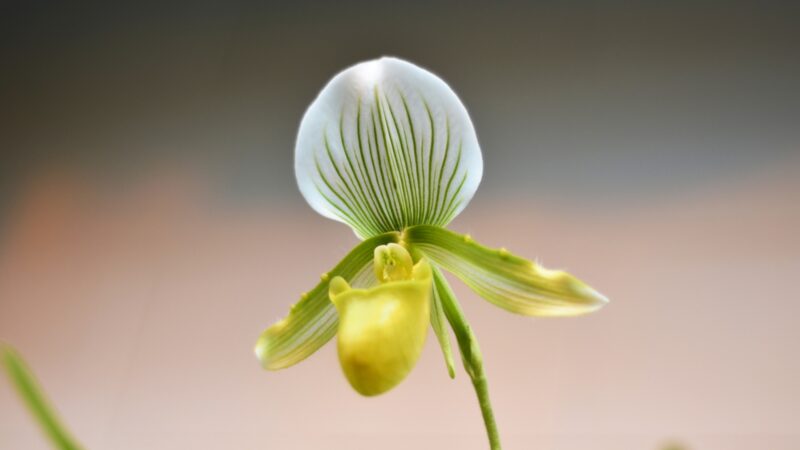
Orchids in this genus are characterized by the slipper or lip-shaped lower pouches found on their flowers. They usually require high humidity, which is difficult to replicate when planting indoors. Nonetheless, these orchids are satisfying to grow due to their blooms that come in a wide range of colors, shapes, sizes, and patterns.
- Paphiopedilum barbatum: Burgundy flowers and mottled dark green leaves
- Paphiopedilum barbigerum: Can be varying shades of pink, red, and purple with medium green leaves
- Paphiopedilum concolor: Cream to peach flowers that are speckled with dark red and have dark green leaves
- Paphiopedilum delenatii: Bright pink to white flowers with mottled leaves
- Paphiopedilum rothschildianum: Purple or brown flowers and clear leaves
4. Dancing Lady Orchids (Oncidium)
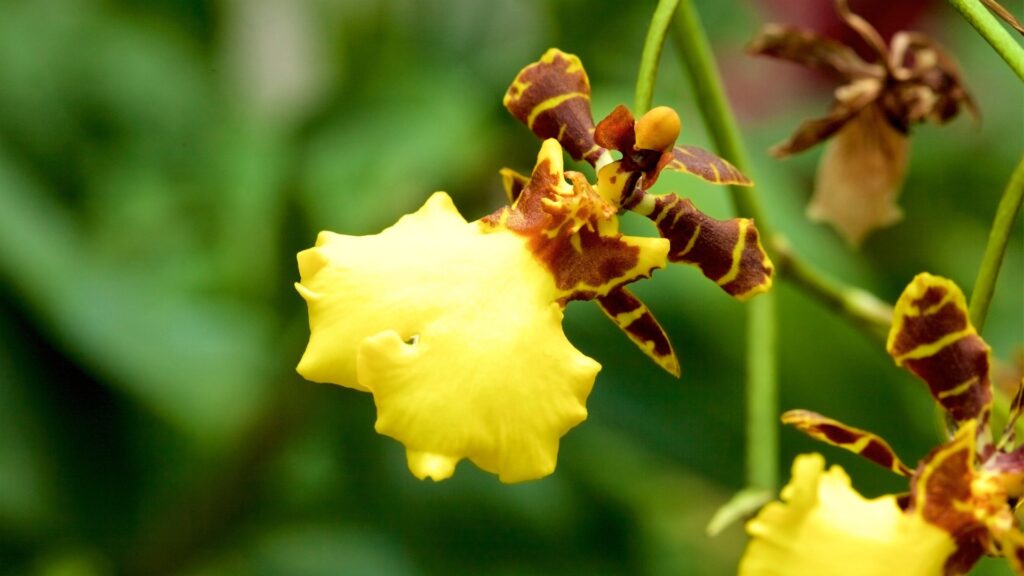
These orchids have highly modified flowers with a ruffled appearance. Although they are difficult to manage, their beautiful, long-lasting, and fragrant displays are worth every effort. This genus has about 600 species and generally requires less humidity compared to other genus.
- Oncidium alexandrae: White flowers with red spots and yellow centers
- Oncidium altissimum: Yellow flowers that are spotted with mahogany
- Oncidium leucochilum: Brown or green flowers with a white lip
- Oncidium sphacelatum: Yellow flowers blotched with brown
- Oncidium tigrinum: Reddish-brown flowers with yellow spots
5. Cane Orchid (Dendrobium)
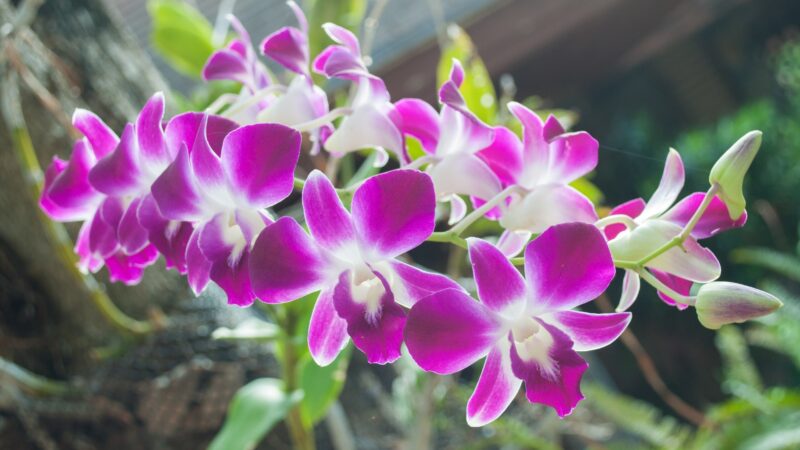
A large genus containing about 1,800 diverse orchid species, Cane Orchids are characterized by their elongated, cane-shaped pseudobulbs and vibrant, showy, and fragrant flowers that come in a variety of colors. Most species go through a growth phase and then a dormant phase in one year.
- Dendrobium kingianum: Purple, red, or white flowers with spots and stripes
- Dendrobium nobile: Variegated white, purple, or pink flowers
- Dendrobium lindleyi: Golden to yellow-orange flowers and dark green leaves
- Dendrobium gracilicaule: Cream, gold, or green flowers with blotches on the back
- Dendrobium salaccense: Yellow flowers with purple on the inner surface
How to Care for Orchids Indoors?
Lighting
It depends on the species, but orchids generally require bright, indirect light. The best location indoors is on a windowsill, ideally on a south or east-facing window.
If a windowsill does not provide adequate lighting, artificial sources may be used, such as high-output, full-spectrum LED, or fluorescent lights that are placed within 6 to 12 inches of the leaves.
Orchid leaves should have a medium, grassy green color to indicate that they are receiving sufficient light. The plants need at least 5 hours of sunlight daily when placed on a windowsill and 14 hours under artificial light.
Water
Sympodial orchids should be allowed to dry completely between waterings, while monopodial orchids should be watered while the media dries.
The best way to determine when the plant needs water, insert your finger into 1 inch of the soil at the center of the container. If it’s dry, you can water your orchids.
Use lukewarm water when watering since cold water can damage and kill roots. Let the water run freely through the bottom of the pot, avoiding getting any foliage wet. This method ensures that any salt and fertilizer build-up is thoroughly flushed from the plant.
Temperature and Humidity
Generally, most orchids thrive in day temperatures between 70°F to 80°F and night temperatures between 60°F to 70°F. Indoor humidity is usually low—lower than what most orchids prefer.
The ideal range would be around 40% to 70% relative humidity. To increase humidity, you can group your orchids or use humidifiers, terrariums, or pebble trays.
Orchids must also receive adequate air to reduce the risk of diseases. Set up a fan or any other equipment that can circulate air when necessary. Make sure the orchids themselves are not blown directly by the fan.
Soil
About 70% of all orchids are epiphytes, which means they do not grow in soil. Instead, they are often planted in sphagnum moss or coarse bark.
Occasionally, they can also be grown in rockwool, clay products, or lava rocks. Whichever medium you prefer, it should be well-drained to keep the aerial roots healthy.
Fertilizer
Apply a specially formulated orchid fertilizer diluted to one-quarter strength once a week while the orchid is producing new growth. As it matures, decreases the rate of fertilization. Stop fertilizing entirely when the plants enter their dormant phase.
Related: When to Use Orchid Food? | 10 Best Orchid Fertilizers
Potting and Repotting
Containers that you can use are net pots, clear plastic pots, terracotta pots and glazed ceramic pots with drainage holes on their sides and bottom, and wooden baskets. Orchids prefer cramped space, so any well-draining container that looks a bit small can work.
Repot when the medium is soggy and no longer dries out well between waterings, or if the roots look shriveled, or when new roots grow outside the pot. Remove the plant from the container, discard the old medium, cut any dead roots, then place it into a new container with fresh medium.
Related: Best Orchid Pots and Containers | Buyers’ Guide
How to Propagate Orchids?
A. Division
- This should be done prior to or just as the plant begins to grow.
- For sympodial orchids, sever the rhizome that joins the pseudobulbs. You can do this by hand or using a razor blade or sterilized knife. Each division should have at least 2 or 3 pseudobulbs and a dormant bud or “live eye.”
- Afterwards, pot these divisions.
- Monopodial orchids can also be propagated through division by cutting the rhizome and making sure there is a “live eye” in each section.
B. Backbulbs
- Backbulbs refer to pseudobulbs that lose their leaves and become dormant. They may possess dormant eyes that can be forced to actively grow.
- Severe at least two backbulbs, making sure they have dormant eyes and one growing shoot. Then, plant in well-drained communal trays or pots.
- Roots and shoots should start growing within 3 to 4 months.
C. Offshoots
- Some orchids, such as dendrobiums, produce plantlets or offshoots at the stems found along the stem. Once these mature, they can be separated from the main plant and then potted.
- Some orchids, such as phalaenopsis, have old flower stalks that can produce offshoots. This can be done by cutting the flower spike above the nodes and then having it potted.
D. Seeds
- Orchids that have been pollinated can produce seed capsules which can be removed from the main plant using a clean-cutting tool or purchased commercially.
- Prepare the potting medium, then sow the seeds directly.
How to Prune Orchids?
Orchids do not need extensive pruning. Simply remove any dead aerial roots and dead leaves using scissors, pruners, or other sharp-cutting equipment that has been sterilized. You can also remove flower stalks when the flowers have faded. Do so by cutting close to the base.
Common Problems With Orchids
- Fertilizer burn. Excess fertilizer can cause root rot, yellowing of leaves, and a build-up of salt in the orchid container. Proper irrigation to flush the potting medium and repotting the plant inside a clean, fresh medium can reduce the risk of this issue.
- Too much light. This is a common problem when you’re moving plants outdoors during the spring season. Too much light can cause the yellowing of leaves and brown spots. This is why transitioning orchids to new sun exposure is important.
- Insufficient light. Orchids do not rebloom due to this reason. Leaves will also become a darker color than usual. Providing supplemental light or moving the plants into a brighter location will stimulate flower production.
- Wrinkled, shriveled, misshapen, or leathery leaves. Caused by insufficient water and is often accompanied by root rot, avoiding overwatering and not letting the plants become too dry between waterings is one way to solve the problem.
- Insects. Among the common insect issues that orchids have are aphids, mites, scales, mealybugs, ants, and cockroaches. Manual control by cleaning off the insects or using bait can control infestations.
Related: Orchid Leaves Turning Yellow | 8 Reasons and Remedies
List of Sources
Guide to Orchid Care and Repotting–bsu.edu (PDF)
Propagating Orchids (PDF)